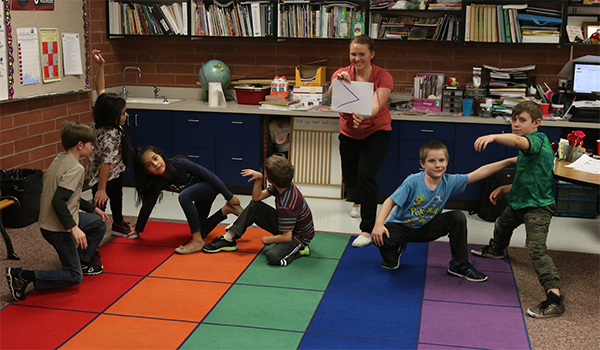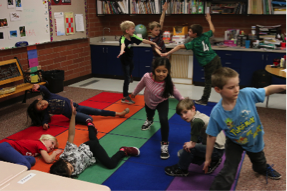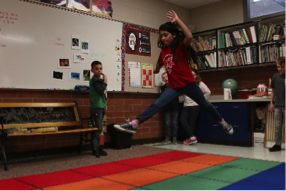SUBJECTS
GRADE
Show Results
Number Ordering

Lesson Summary
- Identify and use the <, >, and = symbols.
- Create and compare groups of dancers.
Lesson Plan and Procedure
Lesson Key Facts
- Grade(s): 2
- Subject(s): Dance, Math
- Duration of lesson: 45 minutes
- Author(s): Erika Cravath and Sara Mann
Note: Print the three symbol signs and the shape chain cards before the lesson.
Experience/Identify
Begin by having students sit in a group on the floor. Engage students in a discussion about the three symbols: greater than (>), less than (<), and equal to (=). Identify with the students each symbol and what it represents.
Teacher: I need six volunteers who will create shapes.
Bring the six volunteer students to the front of the class. Divide the volunteer students into three groups: one group of three, one group of two, and one individual student.
Teacher: With the members of your group, make a connecting shape. If you are by yourself, then create your own shape.
Teacher: Which shape has the largest number of people?
Teacher: Could we say that the group of three is greater than the group of one? (Hold the greater-than sign between the group of three and group of one.) How do you say this number sentence? Three is greater than one. Where does the less-than sign go? Is the group of one smaller than the group of two? How do you say this number sentence? One is less than two. If I switched the signs, would my number sentences be correct?
Invite all students to stand.
Teacher: Make a connecting shape with greater than two people.

Help students to form groups of greater than two and to create a connecting shape within that group. Using the signs, help students to make accurate statements about the groupings.
Teacher: Make a connecting shape with less than three people.
Continue to help students practice making accurate number statements using the signs to reinforce the concept.
Teacher: Make a connecting shape with greater than four people.
Help students form groups of four. Remind them to create a shape that connects all four in their group. Discuss which sign should be used between groupings. Reinforce the concept of equal and the use of the sign.
Continue as time permits to explore different groupings of students using the greater than, less than, and equal to signs to help them make correct statements when comparing the groups.
Explore/Investigate
Activity 1: Level Exploration
Teacher: I am going to turn on some music; when I hold up the greater-than (>) sign, move through the space on a high level. When I hold up the equal-to (=) sign, move on a medium level. When I hold up the less-than (<) sign, move on a low level.

Turn on creative dance music and hold up the signs one at a time. Continue to explore the differing levels, changing the sign you are holding up. Encourage exploration by side coaching, saying things such as the following:
Teacher: Try turning and jumping on a high level. Make interesting shapes while you move through space on a medium level. Can you move to a low level and twist? Explore taking up as much space as you can with your body. Bring your body close into your core.
Activity 2: Surprise Hand Game

Have students form partnerships of two. Instruct them all to hold one hand behind their back and choose a number, holding their fingers up in the number of their choice. On the count of three, students will show each other their numbers. The person with the smaller number (less-than, <) makes a low shape. The student with the bigger number (greater-than, >) makes a high shape. If the numbers are equal (=), their shapes must be on the same level/medium. Students should make their shapes as quickly as possible.
Activity 3: Shape Chain
Hand each student a shape chain card, and instruct the students to keep the symbol on it to themselves. Have the students form two lines. The first person in each line will dance through the space to a spot marked with tape (or a piece of paper), make a shape, and freeze at the level that is written on the card. That student can choose to make any kind of shape—stretched or bent, small or big. Have the rest of the class guess by using the words less than (<) for a low level, equal to (=) for a medium level, and greater than (>) for a high level.
Once the first students are frozen in their shapes, the next person in each line moves through the space and finds a way to make a shape that connects to the first person’s shape. Continue to have students practice guessing the level using less than, equal to, and greater than.
Create/Perform
Divide the class into groups of three or four. Invite the students to work together to create a shape on a high level to represent greater than (>). Create a shape on a middle level to represent equal to (=). And then create a shape on a low level to represent less than (<). They will need to be able to recreate their shapes. Encourage the students to practice their shapes several times so everyone in their group knows the different shapes.
Once students have created their shapes, give further instruction.
Teacher: I will call out a number. If it is less than 100, make your low-level shape. If it is equal to 100, make your mid-level shape. If it is greater than 100, make your high-level shape.
Practice this several times. Change the number you call out, depending on the class’s comprehension. You can call out big numbers like 674 or small numbers like 26.
Teacher: Now we will create a dance with your shapes. When I call out a number, make your shape and hold it until I say, “Go!” When I say that, you will move through the space on the same level as the shape you made, until I call out another number.



Turn on music and practice a few times. Then have each group share their dance with their classmates. The audience members sit down in the space they have been working in, stand to perform while the teacher coaches them through their performances, and then sit back down in their original spots.
Connect/Analyze
Review the three different symbols. Lead a discussion of how the students can remember what each symbol means and how they can use it in their math learning.
Learning Objectives
- Interpret the meaning of symbols.
- Compare numbers using symbols <, >, and =.
- Work with partners.
- Create shapes and move through space.
Utah State Board of Education Standards
This lesson can be used to meet standards in many grades and subject areas. We will highlight one grade’s standards to give an example of application.
Grade 2 Math
- Standard 2.MP.2: Reason abstractly and quantitatively. Make sense of quantities and their relationships in problem situations. Contextualize quantities and operations by using images or stories. Decontextualize a given situation and represent it symbolically. Interpret symbols as having meaning, not just as directions to carry out a procedure. Know and flexibly use different properties of operations, numbers, and geometric objects.
- Standard 2.NBT.4: Compare two three-digit numbers based on meanings of the hundreds, tens, and ones digits, using >, =, and < symbols to record the results of comparisons.
Grade 2 Dance
- Standard 2.D.CR.1: Demonstrate willingness to work with partners when creating dance.
- Standard 2.D.P.1: Move safely in general space through a range of activities and group formations while maintaining personal space.
Equipment and Materials Needed
Additional Resources
ignore
Image References
- Images 1–7: James Huston.

www.education.byu.edu/arts/lessons
 Download
Download